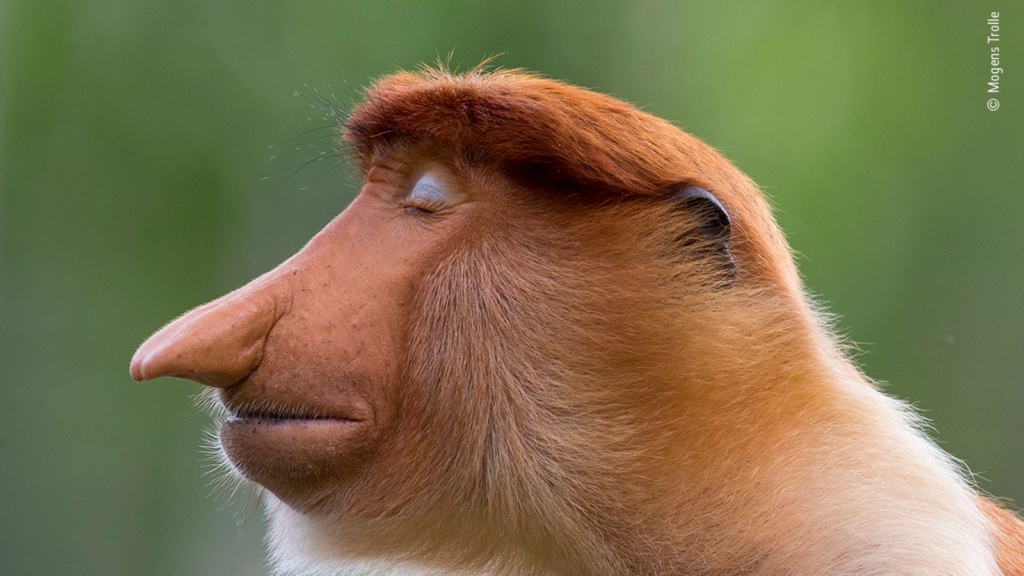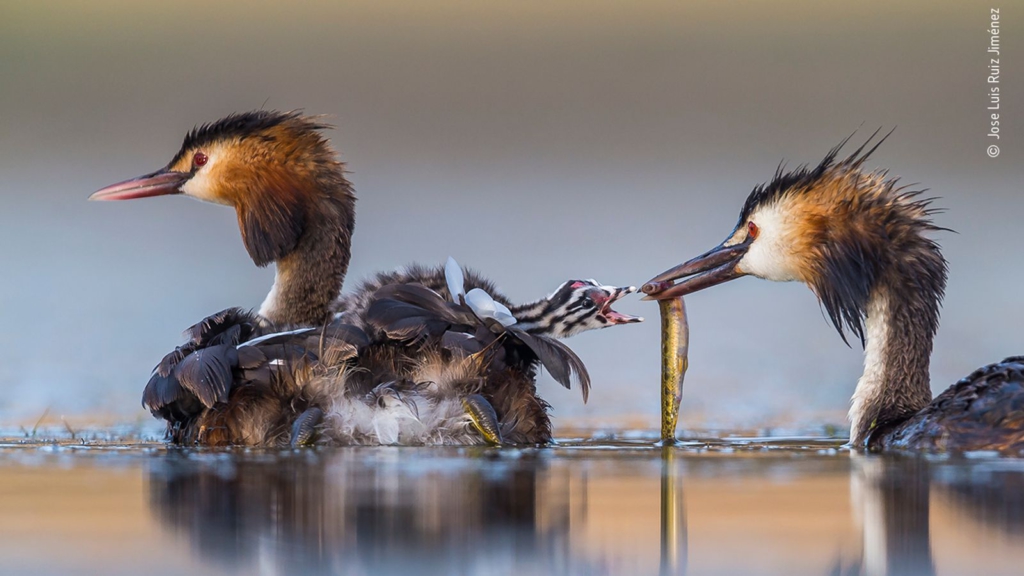This incredible image of a Siberian tiger, a species which has previously been "hunted to the verge of extinction", has won the Wildlife Photographer Of The Year award for 2020.
Selected from more than 49,000 entries from around the world, Sergey Gorshkov's photograph was praised as a "scene like no other" by judges of the annual Natural History Museum competition.
Titled The Embrace, it shows an Amur, or Siberian, tigress hugging an ancient Manchurian fir tree in the Russian Far East. It took the photographer 11 months to capture, using hidden cameras.

It was named the overall winner alongside 16 other category winners, including Liina Heikkinen's Fox That Got The Goose, which earned her the title of Young Wildlife Photographer Of The Year.
Now in its 56th year, the Wildlife Photographer Of The Year competition attracts entries from around the world and is open to snappers of all ages, nationalities and abilities. This year's winner was announced by the Duchess of Cambridge, herself a keen photographer.
Dr Tim Littlewood, the museum's executive director of science, said Gorshkov's "emotive" photo of the tigress offered hope.
"Hunted to the verge of extinction in the past century, the Amur population is still threatened by poaching and logging today.
"The remarkable sight of the tigress immersed in her natural environment offers us hope, as recent reports suggest numbers are growing from dedicated conservation efforts. Through the unique emotive power of photography, we are reminded of the beauty of the natural world and our shared responsibility to protect it."
Here are all the category winners, and the stories behind the striking images.

This European stonechat bird was captured on camera in a meadow near Andres' home in Andalucia, Spain.
The young photographer asked his dad to drive to the meadow and park so he could use the car as a hide, kneel on the back seat and, with his lens on the window sill, shoot this pretty image through the open window.
A Mean Mouthful by Sam Sloss, Italy/US - winner of the 11-14 category

On a diving holiday in North Sulawesi, Indonesia, Sam spotted this clownfish whose mouth was constantly open - but it was only when he downloaded the photos that he saw tiny eyes peeping out of its mouth. The eyes belong to a "tongue-eating louse", a parasitic ispod that swims in through the gills as a male, changes sex and attaches itself to the base of the tongue, sucking blood. When the tongue withers and drops off, the isopod takes its place.
The Pose by Mogens Trolle, Denmark - winner of the Animal Portraits category

This young male proboscis monkey was a wild visitor to a feeding station at the Labuk Bay Proboscis Monkey Sanctuary in Sabah, Borneo. Trolle, who has been photographing primates around the world for five years, described him as "the most laidback character".
Life In The Balance by Jaime Culebras, Spain - winner of the Behaviour: Amphibians and Reptiles category

After walking for four hours in heavy rain, Culebras captured this image of a glass frog eating a spider in the foothills of the Andes, northwestern Ecuador - and found out it was a newly discovered species, distinguished by yellow spots on its back and a lack of webbing between its fingers. Named the Manduriacu glass frog, this is the first ever picture of this species feeding.
Great Crested Sunrise by Jose Luis Ruiz Jimenez, Spain - winner of the Behaviour: Birds category

After several hours chest-deep in water near Brozas, in the west of Spain, Luis managed to capture this great crested grebe family. On this particular morning, he got the shot as the parent on breakfast duty emerged from the water with a meal for the chicks.
A Tale Of Two Wasps by Frank Deschandol, France - winner of the Behaviour: Invertebrates category

This image, showing a red-banded sand wasp and a cuckoo wasp, is the result of painstaking preparation. Deschandol positioned his camera next to a sandy bank near his home in Normandy, northern France, setting up an infrared beam. When broken, this triggered a super-fast shutter system he had built using an old hard drive and positioned in front of the lens, as the camera's own shutter would have been too slow. Despite his tiny subjects and complex technical set-up, he captured the perfect shot.
When Mother Says Run by Shanyuan Li, China - winner of the Behaviour: Mammals category

This is a rare picture of a family of Pallas's cats, or manuls, in the Qinghai-Tibet Plateau in northwest China, the result of six years' work at high altitude. The cats are normally solitary, mostly active at dawn and dusk and usually very hard to find. After long-term observation, Li tracked the family as they descended to about 3,800 metres (12,500 feet) and set up a hide on the hill opposite their lair, an old marmot hole. Hours of patience were rewarded when the three kittens came out to play, while their mother kept her eye on a Tibetan fox lurking nearby.
Out Of The Blue by Gabriel Eisenband, Colombia - winner of the Plants and Fungi category

Eisenband set out to photograph Ritak' Uwa Blanco, the highest peak in the Eastern Cordillera of the Colombian Andes. But in the end, it was the foreground of flowers, known as white arnica, that captured his attention. After sunset, a "blue hour" drenched the scene in an ethereal light.
The Golden Moment by Songda Cai, China - winner of the Under Water category

This image of a tiny diamondback squid paralarva (the stage between hatchling and sub-adult) was taken on a night dive far off the coast of Anilao, in the Philippines. Cai caught the transparent squid in a light beam, turning it to gold.
Watching You Watching Them by Alex Badyaev, Russia/US - winner of the Urban Wildlife category

Cordilleran flycatchers usually nest in crevices and on canyon shelves. However, this pair picked this remote research cabin in Montana's Rocky Mountain Front instead - and happened to be the exact species being studied by biologists there. So as not to disturb them, Badyaev hid his camera behind a large piece of bark on an ancient tree leaning against the cabin and operated the set-up remotely. He captured his shot as the female paused to check on her four nestlings, recording his observations behind her.
Etna's River Of Fire by Luciano Gaudenzio, Italy - winner of the Earth's Environments category

To witness lava flowing on the slope of Mount Etna, Gaudenzioand his colleagues trekked for several hours up the north side of the volcano. Luciano describes the scene as "hypnotic", the vent resembling "an open wound on the rough and wrinkled skin of a huge dinosaur". Taken in 2017, he had been on the nearby island of Stromboli to photograph eruptions there when he heard news of the new vent on Europe's largest volcano, and took the very next ferry over in the hope of getting his shot.
Show Business by Kirsten Luce, US - winner of the Wildlife Photojournalism: Single Image category

Luce has spent several years reporting on animal exploitation and abuse, but says this is the most symbolically shocking scene she has photographed. It shows a muzzled polar bear performing in the Circus On Ice in Russia, reportedly the only known circus to use the animals. The polar bear is one of four females, reportedly captured in Russia's Franz Josef Land when they were two years old - they were "abandoned", the trainer reportedly said - and still performing 18 years later.
Backroom Business by Paul Hilton, UK/Australia - winner of the Wildlife Photojournalist Story Award

This image was one of a series which won Hilton the photojournalist story prize. It shows a young pig-tailed macaque chained to a wooden cage in Bali's bird market, Indonesia. Having convinced the trader he was interested in buying the monkey, Hilton was able to take the photograph in the dark backroom.
Eleonora's Gift by Alberto Fantoni, Italy - winner of the Rising Star Portfolio award

This photo shows a male Eleonora's falcon bringing his mate food - a small bird, probably a lark - on the steep cliffs of a Sardinian island. Fantoni was watching from a hide on San Pietro Island, photographing the adults on their cliff-top perch. Despite feeding his mate, the male bird always seemed reluctant to give up his catch without a struggle, the photographer said.
The Last Bite by Ripan Biswas, India - winner of the Wildlife Photographer Of The Year Portfolio award

These are two ferocious predators - a giant riverine tiger beetle and a weaver ant - the Natural History Museum says, and they don't often meet. These two were captured on a dry riverbed in the Buxa Tiger Reserve, in West Bengal, India, by Biswas as he lay on the sand. "The beetle kept pulling at the ant's leg, trying to rid itself of the ant's grip, but it couldn't quite reach its head," he said.
The Embrace by Sergey Gorshkov, Russia - winner of the Animals In Their Environment category and the overall grand title winner

This beautiful image was taken in the the Land of the Leopard National Park, in the Russian Far East. The population is threatened by poaching and logging, which also impacts their prey but recent camera-trap surveys are encouraging, the Natural History Museum says, indicating a population of between 500 and 600. Gorshkov said he knew his chances of photographing one of the creatures were slim, but he was determined. He installed his first proper camera trap in January 2019, and captured this winning image in the November.
The Fox That Got The Goose by Liina Heikkinen, Finland - winner of the 15-17 category and young wildlife photographer of the year

Liina was inspired to take this picture after hearing about a large fox family living in the city suburbs on the island of Lehtisaari, Helsinki. She spent a day with her father watching the two adults and their six cubs, with the vixen arriving with this abarnacle goose in the evening. After a fight between the cubs, this one was victorious, dragging the bird away and attempting to eat it while blocking access to its hungry siblings.
Winning images will be showcased at the Natural History Museum from 16 October, with safety measures in place due to Coronavirus restrictions, before touring across the UK and internationally
Latest Stories
-
Presidents should have no business in pardoning people – Prof Abotsi
2 minutes -
Samuel Addo Otoo pops up for Ashanti Regional Minister
6 minutes -
Not every ministry needs a minister – Joyce Bawa
30 minutes -
Police shouldn’t wait for President’s directive to investigate election-related deaths – Kwaku Asare
1 hour -
Mahama was intentional in repairing ties with neighbouring countries – Barker-Vormawor
1 hour -
Mahama decouples Youth and Sports Ministry, to create Sports and Recreation Ministry
1 hour -
Mahama’s open endorsement of Bagbin needless – Rabi Salifu
2 hours -
Police station torched as Ejura youth clash with officers
2 hours -
If Ibrahim Traoré goes civilian, it may be because of Mahama’s inauguration – Prof Abotsi
3 hours -
Kwaku Asare welcomes Mahama’s reduction in Ministries but advocates legislative process to cement it
3 hours -
I’m concerned about failure to implement AWW report – Prof Abotsi
3 hours -
US returns $50m in alleged stolen funds to Nigeria
3 hours -
Mahama restructures Ministries, reduced from 30 to 23 – See full list
4 hours -
2 siblings die after being locked in water drum by 6-year-old sister
4 hours -
Mahama shouldn’t have openly directed Parliament to elect Speaker – Prof. Kwaku Asare
4 hours

